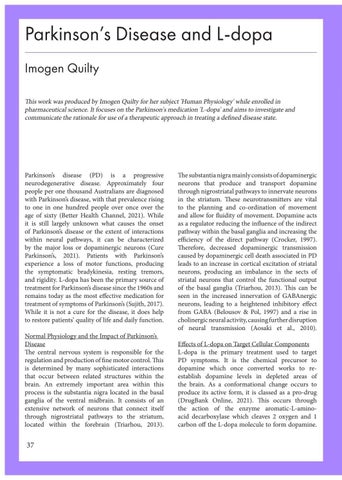Parkinson’s Disease and L-dopa Imogen Quilty This work was produced by Imogen Quilty for her subject 'Human Physiology' while enrolled in pharmaceutical science. It focuses on the Parkinson's medication 'L-dopa' and aims to investigate and communicate the rationale for use of a therapeutic approach in treating a defined disease state.
Parkinson’s disease (PD) is a progressive neurodegenerative disease. Approximately four people per one thousand Australians are diagnosed with Parkinson’s disease, with that prevalence rising to one in one hundred people over once over the age of sixty (Better Health Channel, 2021). While it is still largely unknown what causes the onset of Parkinson’s disease or the extent of interactions within neural pathways, it can be characterized by the major loss or dopaminergic neurons (Cure Parkinson’s, 2021). Patients with Parkinson’s experience a loss of motor functions, producing the symptomatic bradykinesia, resting tremors, and rigidity. L-dopa has been the primary source of treatment for Parkinson’s disease since the 1960s and remains today as the most effective medication for treatment of symptoms of Parkinson’s (Sujith, 2017). While it is not a cure for the disease, it does help to restore patients’ quality of life and daily function. Normal Physiology and the Impact of Parkinson’s Disease The central nervous system is responsible for the regulation and production of fine motor control. This is determined by many sophisticated interactions that occur between related structures within the brain. An extremely important area within this process is the substantia nigra located in the basal ganglia of the ventral midbrain. It consists of an extensive network of neurons that connect itself through nigrostriatal pathways to the striatum, located within the forebrain (Triarhou, 2013).
37
The substantia nigra mainly consists of dopaminergic neurons that produce and transport dopamine through nigrostriatal pathways to innervate neurons in the striatum. These neurotransmitters are vital to the planning and co-ordination of movement and allow for fluidity of movement. Dopamine acts as a regulator reducing the influence of the indirect pathway within the basal ganglia and increasing the efficiency of the direct pathway (Crocker, 1997). Therefore, decreased dopaminergic transmission caused by dopaminergic cell death associated in PD leads to an increase in cortical excitation of striatal neurons, producing an imbalance in the sects of striatal neurons that control the functional output of the basal ganglia (Triarhou, 2013). This can be seen in the increased innervation of GABAnergic neurons, leading to a heightened inhibitory effect from GABA (Belousov & Pol, 1997) and a rise in cholinergic neural activity, causing further disruption of neural transmission (Aosaki et al., 2010). Effects of L-dopa on Target Cellular Components L-dopa is the primary treatment used to target PD symptoms. It is the chemical precursor to dopamine which once converted works to reestablish dopamine levels in depleted areas of the brain. As a conformational change occurs to produce its active form, it is classed as a pro-drug (DrugBank Online, 2021). This occurs through the action of the enzyme aromatic-L-aminoacid decarboxylase which cleaves 2 oxygen and 1 carbon off the L-dopa molecule to form dopamine.









